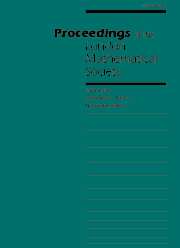Article contents
The class number one problem for some non-abeliannormal CM-fields of 2-power degrees
Published online by Cambridge University Press: 01 May 1998
Abstract
First, we prove that a non-abelian normal CM-field of degree 16 has odd relative class number if and only if it is dihedral, or is a compositum of two normal octic CM-fields with the same maximal real subfield, or has Galois group $G_9 =\langle a,b,z: a^2=b^2=z^4=1,b^{-1}ab=az^2,az=za,bz=zb\rangle$. Then, we solve several relative class number one problems. (1) We solve the relative class number one problem for the dihedral CM-fields of 2-power degrees. First, we remind the reader of the characterization of the dihedral CM-fields of 2-power degrees with odd relative class numbers. Second, we give lower bounds on relative class numbers of dihedral CM-fields of 2-power degrees with odd relative class numbers. We thus obtain an upper bound on the discriminants of the dihedral CM-fields of 2-power degrees with relative class number equal to 1. Third, we compute the relative class numbers of all the dihedral CM-fields of 2-power degrees with odd relative class numbers and discriminants less than or equal to this latter bound. We end up with a list of twenty-four dihedral CM-fields of 2-power degrees with relativeclass numbers equal to 1, and show that exactly twenty-one of them have class number 1. (2) We determine all the non-abelian normal CM-fields of degree 16 with Galois group $G_9$ which have relative class number 1 (there is only one such number field), and then those which have class number 1 (there is only one such number field). (3) We determine some of the non-abelian normal CM-fields $N =N_1N_2$ of degree 16 which are composita of two normal octic CM-fields $N_1$ and $N_2$ with the same maximal real subfield which have relative class number 1, and then those which have class number 1. Indeed, we focus on the case where one of the $N_i$ is a quaternion octic CM-field and prove that there is only one such compositum with relative class number 1 and that this compositum has class number 1.
1991 Mathematics Subject Classification: primary 11R29; secondary 11R21, 11R42, 11M20, 11Y40.
- Type
- Research Article
- Information
- Copyright
- London Mathematical Society 1998
- 12
- Cited by


